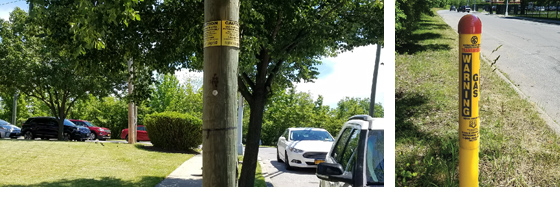| Learn to recognize gas pipeline markers |
| High-visibility markers are sometimes used to indicate the approximate location of high-pressure underground pipelines. These markers display the name of the pipeline |
operator, the type of product carried in the pipeline and a 24-hour telephone number where the operator can be reached in the event of an emergency.
Natural gas transmission pipeline markers are generally yellow and black. National Grid’s gas pipeline markers are usually freestanding; in urban areas they may also be found on utility poles. Here are examples of our natural gas pipeline markers:
|
|
 |
| Where you’ll find them |
Natural gas pipeline markers are placed near our pipelines but not necessarily directly on top of them. These markers are usually found at roadways, railroad crossings and other points along the pipeline route.
For security purposes, pipeline markers do not show the exact location, path, depth or number of gas pipelines in the area. In addition, pipelines may not follow a straight course between markers. So while these markers can help you identify the general location of our gas transmission pipelines, you cannot use them to determine a pipeline’s precise location.
A more reliable way to locate gas pipelines in your response area is to register with the National Pipeline Mapping System (NPMS) at https://www.npms.phmsa.dot.gov.
|
| Gas transmission pipelines call for extra care |
| • |
|
A National Grid representative must be onsite to supervise any excavation within
15 feet of a high-pressure natural gas transmission pipeline. If you see excavation
occurring near a pipeline marker with no utility personnel present, call the number
listed on the marker. |
|
| Pipelines can be damaged during accidents, emergency response and/or cleanup activities in an accident’s aftermath |
| • |
|
Once a natural gas transmission pipeline’s location is established, take care to park
emergency vehicles where their weight will not damage the pipeline. |
| • |
|
Additionally, be sure emergency cleanup and excavation equipment, such as backhoes, are
operated a safe distance away from the pipeline. |
|